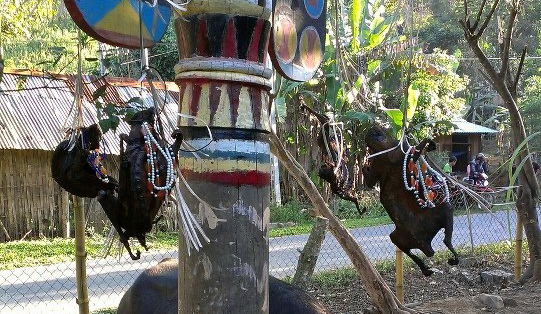Recent gun hunting in the jungles of central Vietnam has driven the flying lemur – a kind of weasel that produces delicious meat with supposedly medical properties -- to near extinction.
Commonly called the flying lemur, the animal is not a lemur but a species of colugo with the scientific name Cynocephalus variegates. With a head-body length of 34-38cm and weighing around one kilogram, the species in Vietnam is called Sunda, or the Malayan flying lemur. It can be found throughout Southeast Asia in countries such as Indonesia, Thailand, Malaysia, and Singapore. A smaller Philippine flying lemur can be found in the country it is named after.
In Vietnam, the high S’Tieng mountains in Tay Giang District, Quang Nam Province have been considered ‘the capital city’ of the flying lemur for decades. The ethnic Co Tu people have also lived in the area and trapped the animal for its meat for generations.
The species has recently approached the brink of extinction as the meat has become a specialty dish in city restaurants and hunters have scoured the jungles with guns to hunt it down. A kilogram is sold for prices ranging from VND600,000 – 800,000 (US$38).
As it becomes rarer and rarer, the price of its meat keeps on increasing, even though the species is listed in the Red Book for protection. Thanks to deforestation and loss of habitat, it can only be found in sanctuaries or national parks under the protection of rangers.
A local named A Lang Bot, from A Rot Village in Quang Nam, said he and his neighbors used to trap the flying lemur, not shoot it.
“If we shoot it, other animals can smell the blood and abandon the area,” he said.
The trapping of the flying lemur by the Co Tu for decades has never affected the population of the species, he added. But shooting the animal to sell to restaurants has had a different result.

The bodies of dead flying lemurs hung on a pole as offering to God during a ceremony of Co Tu ethnic minority people (Photo: Tuoi Tre)
The animal’s meat and intestines are good for Apứ -- a specialty – as the animal mainly feeds on soft plant parts such as young leaves, shoots, flowers, and fruits. It also eats herbs in the wild jungle and thus its meat is purported to have medical properties.
“Before, we led a happier life than now because we had more birds and wild beasts. The jungles were wild. Now lowlanders come to buy all that we have. The jungles have emptied, and life is getting harder,” said Bot.
The flying lemur, which is active at night and strictly arboreal, is a skilled climber but is helpless when on the ground. Its gliding membrane connects from the neck, extending along the limbs to the tips of its fingers, toes and nails. This kite-shaped skin helped the animal gain the ‘flying’ part of its name.
Clau Nam, a patriarch of Lang village in the province, said the animal mostly flies in spring and early summer when fruits ripen and buds erupt.
The Co Tu place traps high on tree trunks, as after landing on a tree, the animal has to climb up to begin another glide, thus entering the trap, he said.
During the annual buffalo-stabbing ceremony of the Co Tu, the flying lemur is slaughtered and hung on a pole as an offering to God. The flying lemur is offered as a symbol of intelligence, Nam added.





















































